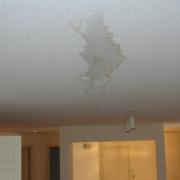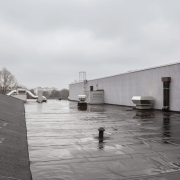Ponding Water on Flat Roof
Ponding Water on Flat Roof
Flat roofs are a common type of roofing usually found on commercial properties. There have been a growing number or residential homes sporting this type of roof because of the modern aesthetic it provides. There are a variety of materials used to create a flat roof, however, the main defining feature is that it is flat or at lease has a very low slope.
By nature, flat roofs typically collect rainwater. Unlike roofs with a much higher slope, flat roofs are not able to allow rainwater or melted snow to drain away as quickly. Instead, it is imperative that a flat roof structure have a reliable, efficient, and effective drainage system to prevent ponding.
Ponding on a flat roof refers to when water collects and creates small pools or “ponds.” While most of these small pools eventually drain off or even evaporate over a few hours, it can become problematic when pooling water stands on top of a roof for 2 days or more. The water may seep into the roofing material and cause damage inside, cause leakage, and potentially damage the roof even further if not fixed. Excessive ponding threatens your roof. On top of that, ponding can also void your warranty.
When a flat roof is consistently ponding or collecting water, it can be a worsening problem that needs to be addressed quickly.
The main reason that this occurs on a flat roof is that the slope is too low for water to efficiently drain off your roof with just the aid of gravity. This is why flat roofs should also have an efficient drainage system to avoid pooling. Since you can’t increase the slope of your roof right away, one of the first things you need to do is check on your drainage systems and make sure that none of them have been clogged up. Most of the time, pooling is also caused by blocked or obstructed drainage. If you are unable to check on your roof’s drainage system, contacting a roofing expert to pinpoint the cause of the problem is the fastest and most efficient way to get it fixed.
While it might not seem like an urgent problem, ponding on a flat roof needs to be addressed as soon as possible, SImply ignoring the problem with the hope that it will drain away or evaporate eventually will only cause even more damage. And with more damage, you might end up spending way more if you wait.
What can Happen if you Ignore Ponding on a Flat Roof?
The most common problem is that you’ll have a leaking roof. In most cases, people spot the leak before they realize there is standing water on their roof. Since water moves down, it will find the lowest point of your roof and from there may eventually sink down further into the underlayment and through to your ceiling. If your roof has any cracks or small openings, water will eventually find its way there. Even when there are no openings, water can also weaken the structure of your roof.
The problem compounds on itself. As more and more water collects in a certain area of your roof, the added weight forms an indentation that will make that spot lower than the rest of the roof. When this happens, it causes even more water to pool in the area. This adds even more weight and deepens the area even further. The worst case scenario is that area eventually collapsing which won’t just mean massive damages and skyrocketing repair expenses, it is also hazardous to the people in the property.
One more way that the pooled water can cause damage to your roof is through acting as a magnifying glass that concentrates the UV rays from the sun. This can hasten the degradation of your roofing materials.
Aside from that, there are even more ways that ponding water can damage your roof. In order to avoid any of the major damages that ponding water can cause, it is always best to seek the help of your local experts at Wade Exteriors. Not only will we find you a quick and long-lasting solution, we provide you with the right solution that will prevent water from ponding the next time there’s a downpour.






